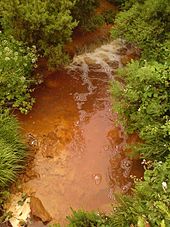Water Pollution
What is it?
Water pollution is the contamination of water bodies, usually as a result of human activities. Water bodies include lakes, rivers, oceans, aquifers and groundwater. Water pollution results when contaminants are introduced into the natural environment. For example, releasing inadequately treated wastewater into natural water bodies can lead to degradation of aquatic ecosystems.
What affects?
Water pollution affects the entire biosphere. Plants and organisms living in or being exposed to polluted water bodies are impacted. The effect can damage individual species and impact the natural biological communities they are part of. Water pollution can be grouped into surface water pollution and groundwater pollution. Marine pollutionis a subset of water pollution, and can be studied separately.
There are different types:
Surface water pollution
Surface water pollution includes pollution of rivers, lakes and oceans. A subset of surface water pollution is marine pollution.
Marine pollution
One common path of entry by contaminants to the sea are rivers. An example is directly discharging sewage and industrial waste into the ocean. Pollution such as this occurs particularly in developing nations.
Large gyres in the oceans trap floating plastic debris. Plastic debris can absorb toxic chemicals from ocean pollution, potentially poisoning any creature that eats it. Many of these long-lasting pieces end up in the stomachs of marine birds and animals. This results in obstruction of digestive pathways, which leads to reduced appetite or even starvation.
There are a variety of secondary effects stemming not from the original pollutant, but a derivative condition. An example is silt-bearing surface runoff, which can inhibit the penetration of sunlight through the water column, hampering photosynthesis in aquatic plants.
Groundwater pollution
Interactions between groundwater and surface water are complex. Consequently, groundwater pollution, also referred to as groundwater contamination, is not as easily classified as surface water pollution.[11] By its very nature, groundwater aquifers are susceptible to contamination from sources that may not directly affect surface water bodies. The distinction of point vs. non-point source may be irrelevant.
Analysis of groundwater contamination may focus on soil characteristics and site geology, hydrogeology, hydrology, and the nature of the contaminants. Causes of groundwater pollution include: naturally-occurring (geogenic), on-site sanitation systems, sewage, fertilizers and pesticide, commercial and industrial leaks, hydraulic fracturing, landfill leachate.
Control Pollution:
Nature-based solutions are also being used instead of (or in combination with) centralized treatment plants. In urban areas of developed countries, municipal wastewater (or sewage) is typically treated by centralized sewage treatment plants. Well-designed and operated systems (i.e., with secondary treatment steps or more advanced treatment) can remove 90 percent or more of the pollutant load in sewage. Some plants have additional systems to remove nutrients and pathogens, but these more advanced treatment steps get progressively more expensive.
Cities with sanitary sewer overflows or combined sewer overflows employ one or more engineering approaches to reduce discharges of untreated sewage, including:
- utilizing a green infrastructure approach to improve storm water management capacity throughout the system, and reduce the hydraulic overloading of the treatment plant.
- repair and replacement of leaking and malfunctioning equipment.
- increasing overall hydraulic capacity of the sewage collection system (often a very expensive option).
https://youtu.be/Zk1J2EW-nmQ
https://en.wikipedia.org/wiki/Water_pollution













